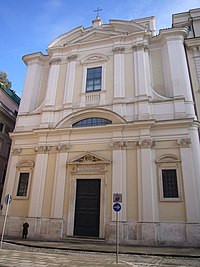History
The church was founded in the early Middle Ages, probably in the 7th century. It is first mentioned in the Liber Pontificalis under Pope Hadrian I, using spolia from the ruins of an imperial building. The first priests who served the church were probably eastern Basilian monks who had fled from persecution during the iconoclast period.
It is listed in the Catalogue of Turin as a papal chapel with eight clerics and in 1574 was granted to the Jesuits by Pope Gregory XIII, and it was used as the church of the next-door Collegium Germanicum in the Palazzo di Sant'Apollinare, which was later united with the Hungarian College to form the Collegium Germanicum et Hungaricum. This remained a Jesuit institution until the suppression of the Jesuits in 1773, when this church passed to the Lazarists.
In the late 17th century, the church was in a poor state of repair. Its rebuilding was considered over a long period but wasn't carried out, probably due to the lack of funds. Despite this, in 1702 a chapel was redecorated and dedicated to St Francis Xavier, and a statue of the saint commissioned from Pierre Le Gros who carved the marble with extraordinary virtuosity (the statue was preserved when the church was eventually rebuilt some 40 years later and is still in situ). [1]
Only in 1742, Pope Benedict XIV commissioned Ferdinando Fuga to rebuild the church. Fuga added a new façade in the late 16th century style, with Baroque elements. It has two stories, with Ionic columns in the lower and Corinthian ones in the upper. The lower level has a central doorway flanked by windows. Above the door is a triangular tympanon. On the upper level is a large central window with a balcony, and two smaller windows to the sides. The façade is crowned by a double tympanon. Fuga also reconstructed the dome. The church as a whole was rededicated in 1748.
Francesco Antonio Zaccaria, writer and archaeologist, who died in 1795, was buried in the Chapel of St Ignatius of Loyola here.
In 1984 the church was elevated to minor basilica status. [2]
In 18 December 1990, the church was granted to the Opus Dei, and is now part of their Pontifical University of the Holy Cross. The new Chaplain of the Opus Dei settled in 1 September 1991. In 24 April 1990, when the Church had not yet been entrusted to Opus Dei, the notorious gangster Enrico De Pedis, boss of the so-called Banda della Magliana, was buried in the church's crypt, by authorization of Cardinal Ugo Poletti. The unusual interment has been linked to the case of Emanuela Orlandi's kidnapping [3] and the tomb was opened for investigation in 2012. [4] In 18 June 2012, the remains of De Pedis were transferred to the cemetery of Verano.
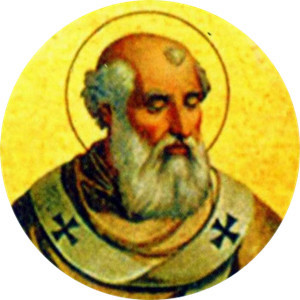
Pope Zachary reigned from 3 December or 5 December 741 to his death in 752. A Greek from Santa Severina, Calabria, he was the last pope of the Byzantine Papacy. Most probably he was a deacon of the Roman Church and as such signed the decrees of the Roman council of 732, and succeeded Gregory III on 5 December 741.

Ravenna is the capital city of the Province of Ravenna, in the Emilia-Romagna region of Northern Italy. It was the capital city of the Western Roman Empire from 402 until that empire collapsed in 476. It then served as the capital of the Ostrogothic Kingdom until it was re-conquered in 540 by the Byzantine Empire. Afterwards, the city formed the centre of the Byzantine Exarchate of Ravenna until the invasion of the Lombards in 751, after which it became the seat of the Kingdom of the Lombards.

San Saba is an ancient basilica church in Rome, Italy. It lies on the so-called Piccolo Aventino, which is an area close to the ancient Aurelian Walls next to the Aventine Hill and Caelian Hill.
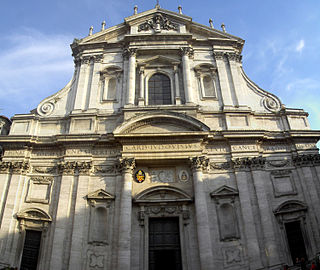
The Church of St. Ignatius of Loyola at Campus Martius is a Roman Catholic titular church, of deaconry rank, dedicated to Ignatius of Loyola, the founder of the Society of Jesus, located in Rome, Italy. Built in Baroque style between 1626 and 1650, the church functioned originally as the chapel of the adjacent Roman College, that moved in 1584 to a new larger building and was renamed the Pontifical Gregorian University.

The Church of Saint Andrew's at the Quirinal is a Roman Catholic titular church in Rome, Italy, built for the Jesuit seminary on the Quirinal Hill.
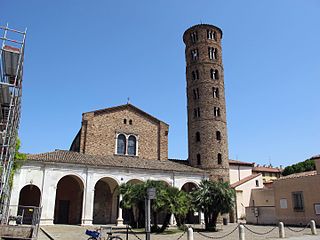
The Basilica of Sant' Apollinare Nuovo is a basilica church in Ravenna, Italy. It was erected by the Ostrogothic king Theodoric the Great as his palace chapel during the first quarter of the 6th century. This Arian church was originally dedicated in 504 AD to "Christ the Redeemer".

The Basilica of Sant' Apollinare in Classe is an important monument of Byzantine art near Ravenna, Italy. When the UNESCO inscribed eight Ravenna sites on the World Heritage List, it cited this basilica as "an outstanding example of the early Christian basilica in its purity and simplicity of its design and use of space and in the sumptuous nature of its decoration".

Ferdinando Fuga was an Italian architect who was born in Florence, and is known for his work in Rome and Naples. Much of his early work was in Rome, notably, the Palazzo della Consulta (1732–7) at the Quirinal, the Palazzo Corsini (1736–54), the façade of the Santa Maria Maggiore (1741–3), and the Church of Sant'Apollinare (1742–8). He later moved to Naples and notably designed the Albergo de'Poveri (1751–81), the façade of the Church of the Gerolamini, and that of the Palazzo Giordano.

The Basilica of St. Stephen in the Round on the Celian Hill is an ancient basilica and titular church in Rome, Italy. Commonly named Santo Stefano Rotondo, the church is Hungary's "national church" in Rome, dedicated to both Saint Stephen, the first Christian martyr, and Stephen I, the sanctified first king of Hungary who imposed Christianity on his subjects. The minor basilica is also the rectory church of the Pontifical Collegium Germanicum et Hungaricum.

Santo Stefano degli Ungheresi was the church of the Hungarians in Rome. Located next to the Vatican, the old church was pulled down in 1778, to make room for an extension of St. Peter's Basilica.

The Italian Catholic Diocese of Adria-Rovigo, in the Triveneto, has existed under this name since 1986. It is a Latin suffragan to the Patriarchate of Venice.

Pierre Le Gros was a French sculptor, active almost exclusively in Baroque Rome. Nowadays, his name is commonly written Legros, while he himself always signed as Le Gros; he is frequently referred to either as 'the Younger' or 'Pierre II' to distinguish him from his father, Pierre Le Gros the Elder, who was also a sculptor. The "ardent drama" of his work and its Italian location make him more an Italian, than a French, sculptor. Despite being virtually unknown to the general public today, he was the pre-eminent sculptor in Rome for nearly two decades, until he was finally superseded at the end of his life by the more classicizing Camillo Rusconi.
Ugo Poletti was an Italian Cardinal of the Roman Catholic Church who served as Vicar General of Rome from 1973 to 1991, and was elevated to the cardinalate in 1973.
The Collegium Germanicum et Hungaricum or simply Collegium Germanicum is a German-speaking seminary for Roman Catholic priests in Rome, founded in 1552. Since 1580 its full name has been Pontificium Collegium Germanicum et Hungaricum de Urbe.
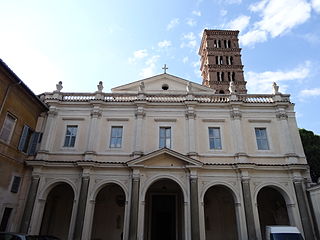
The Basilica dei Santi Bonifacio e(d) Alessio is a basilica, rectory church served by the Somaschans, and titular church for a cardinal-priest on the Aventine Hill in the third prefecture of central Rome, Italy.

Bernardino Ludovisi, also called Bernardo, was an Italian sculptor.

San Girolamo della Carità is a church in Rome, Italy, located near the Palazzo Farnese and Campo de' Fiori.

The church of San Macuto is a church on Piazza di San Macuto in the Colonna rione of Rome, Italy. Located next to the Jesuit Collegio di San Roberto Bellarmino in the Palazzo Gabrielli-Borromeo, it is the only church in Italy dedicated to the Breton saint Malo.

The Church of Saint Anne in the Vatican, known as Sant'Anna de' Parafrenieri, is a Roman Catholic parish church dedicated to Saint Anne in Vatican City. The church is the parish church of the State of Vatican City and is placed under the jurisdiction of the Vicariate of the Vatican City and is located beside the Porta Sant'Anna, an international border crossing between Vatican City State and Italy.

The Domus Internationalis Paulus VI, was established as a Foundation by Pope John Paul II on 6 January 1999. The purpose of the Domus is to accommodate clergy who are assigned to the diplomatic service of the Holy See, or who are officials of the Roman Curia. The Domus is at the Southern wing of the Palazzi di S. Apollinare. It is an historic Palazzo located in the ancient centre of Rome, and one of the four residences of the Officials of the Roman Curia in Rome; the other three are Domus Sanctae Marthae within the Vatican Walls, the Casa San Benedetto at via dell'Erba, and the Domus Romana Sacerdotalis at via Traspontina. The last two are located near the St. Peter's Square. Cardinals, bishops and priests who visit the Pope in Rome or who participate in the various apostolic works of the Holy See also stay at the Domus. The Domus is near the Vatican, notable Roman monuments, and famous sights.
